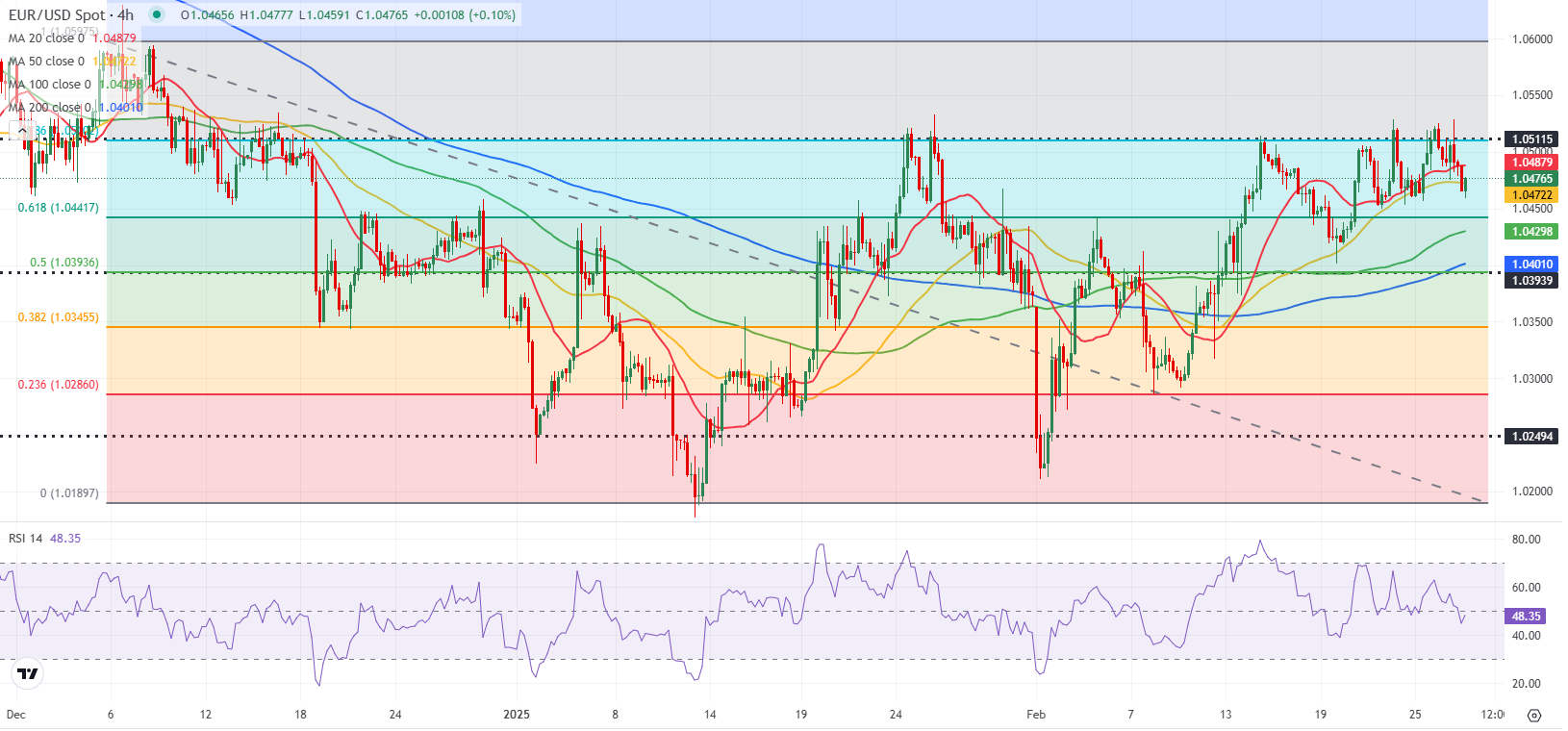
- EUR/USD trades below 1.0500 after closing in the negative territory on Wednesday.
- US President Trump plans to impose 25% tariff on EU imports of autos and other goods.
- The technical outlook shows buyers’ reluctance in the near term.
EUR/USD lost its traction and posted losses on Wednesday. The pair stays on the back foot in the early European session on Thursday and trades below 1.0500.
Euro PRICE This week
The table below shows the percentage change of Euro (EUR) against listed major currencies this week. Euro was the weakest against the British Pound.
| USD | EUR | GBP | JPY | CAD | AUD | NZD | CHF | |
|---|---|---|---|---|---|---|---|---|
| USD | -0.14% | -0.28% | 0.01% | 0.78% | 0.84% | 0.91% | -0.18% | |
| EUR | 0.14% | -0.23% | -0.02% | 0.74% | 0.97% | 0.87% | -0.21% | |
| GBP | 0.28% | 0.23% | 0.30% | 0.97% | 1.21% | 1.10% | 0.03% | |
| JPY | -0.01% | 0.02% | -0.30% | 0.75% | 0.90% | 0.97% | -0.10% | |
| CAD | -0.78% | -0.74% | -0.97% | -0.75% | 0.01% | 0.13% | -0.94% | |
| AUD | -0.84% | -0.97% | -1.21% | -0.90% | -0.01% | -0.11% | -1.17% | |
| NZD | -0.91% | -0.87% | -1.10% | -0.97% | -0.13% | 0.11% | -1.06% | |
| CHF | 0.18% | 0.21% | -0.03% | 0.10% | 0.94% | 1.17% | 1.06% |
The heat map shows percentage changes of major currencies against each other. The base currency is picked from the left column, while the quote currency is picked from the top row. For example, if you pick the Euro from the left column and move along the horizontal line to the US Dollar, the percentage change displayed in the box will represent EUR (base)/USD (quote).
The negative shift seen in risk mood supported the US Dollar (USD) on Wednesday and caused EUR/USD to stretch lower. Additionally, US President Donald Trump said that they are planning to impose tariffs on European imports, further weighing on the pair. He noted that they will share details on EU tariffs soon, while adding that they are likely to be 25% on autos and some other goods.
In response, “the EU will react firmly and immediately against unjustified barriers to free and fair trade, including when tariffs are used to challenge legal and non-discriminatory policies,” the European Commission said.
In the second half of the day, the US Bureau of Economic Analysis will release the second estimate of the fourth-quarter Gross Domestic Product (GDP) data. A downward revision could limit the USD’s gains with the immediate reaction and help EUR/USD find support. The US economic calendar will also feature the weekly Initial Jobless Claims data, which is forecast to edge higher to 221,000 in the week ending February 22, from 219,000 in the previous week.
Later in the American session, Trump is scheduled to hold a press conference following his meeting with British Prime Minister Keir Starmer.
EUR/USD Technical Analysis
EUR/USD closed the last 4-hour candle below the 20-period and the 50-period Simple Moving Averages (SMA) and the Relative Strength Index (RSI) indicator declined slightly below 50, reflecting buyers’ reluctance.
On the downside, 1.0440 (Fibonacci 61.8% retracement of the latest downtrend) could be seen as first support before 1.0390-1.0400 (50-day SMA, Fibonacci 50% retracement) and 1.0350 (Fibonacci 38.2% retracement). Looking north, resistances could be spotted at 1.0500-1.0510 (round level, Fibonacci 78.6% retracement), 1.0535 (100-day SMA) and 1.0600 (beginning point of the downtrend).
Tariffs FAQs
Tariffs are customs duties levied on certain merchandise imports or a category of products. Tariffs are designed to help local producers and manufacturers be more competitive in the market by providing a price advantage over similar goods that can be imported. Tariffs are widely used as tools of protectionism, along with trade barriers and import quotas.
Although tariffs and taxes both generate government revenue to fund public goods and services, they have several distinctions. Tariffs are prepaid at the port of entry, while taxes are paid at the time of purchase. Taxes are imposed on individual taxpayers and businesses, while tariffs are paid by importers.
There are two schools of thought among economists regarding the usage of tariffs. While some argue that tariffs are necessary to protect domestic industries and address trade imbalances, others see them as a harmful tool that could potentially drive prices higher over the long term and lead to a damaging trade war by encouraging tit-for-tat tariffs.
During the run-up to the presidential election in November 2024, Donald Trump made it clear that he intends to use tariffs to support the US economy and American producers. In 2024, Mexico, China and Canada accounted for 42% of total US imports. In this period, Mexico stood out as the top exporter with $466.6 billion, according to the US Census Bureau. Hence, Trump wants to focus on these three nations when imposing tariffs. He also plans to use the revenue generated through tariffs to lower personal income taxes.

